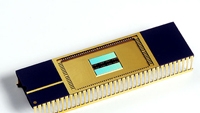PCM memory set to hit the market

It has been 38 years since it was first announced, but phase change memory (PCM) is finally ready to hit the market. In a few years, experts say it could be cheaper and better than Flash memory.
PCM memory will be produced by Numonyx, a memory joint venture between STMicroelectronics and Intel. Samples are already shipping, and commercial availability is set for later this year.
The delay has been long because manufacturing is difficult. Both Intel and ST made a significant amount of progress in controlling the material in the past few years.
CNET explained that in PCM chips, a microscopic bit on a substrate gets heated up to between 150 degrees and 600 degrees Celsius. The substrate is made of the same stuff as CD disks. The heat melts the bit, which when cooled solidifies into one of two crystalline structures, depending on how fast the cooling takes place. The two different crystalline structures exhibit different levels of resistance to electrical current, and those levels of resistance in turn are then as ones or zeros by a computer. Data is born.
The benefit of PCM is performance. The chips can survive tens of millions of read-write cycles — far more than Flash. Reading data to PCM chips takes 70 to 100 nanoseconds. Data can be written to the chips at a rate of 1MB/s. PCM offers the best attributes of three different types of memory — plus it will potentially use far less power.
Scientists believe they will be able to increase the density of these chips comparatively easily. In the future, standard Flash chips will need additional circuitry for error correction and other functions. This is not the case with PCM. The smaller the bits get, the less heat that will be required to flip them.
The professional video industry's #1 source for news, trends and product and tech information. Sign up below.
